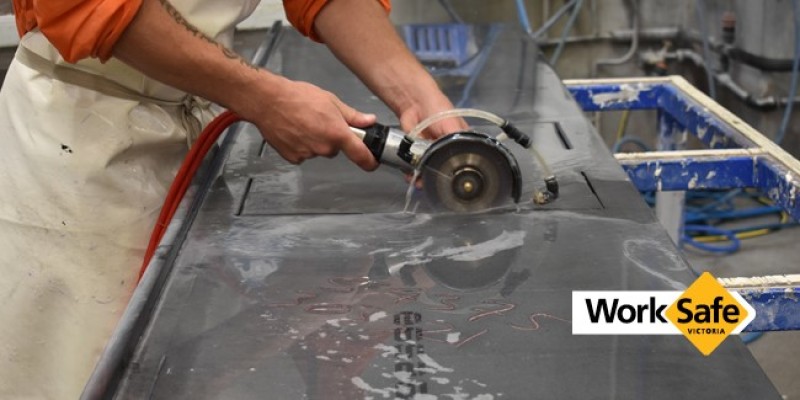Understanding Australia’s Recent Silicosis Laws for Engineered Stone: What You Need to Know
In recent years, there has been growing concern over the health risks associated with engineered stone products, particularly concerning the inhalation of crystalline silica dust during fabrication and installation. Silicosis, an incurable lung disease caused by inhaling dry crystalline silica particles, has become a significant occupational health issue, prompting governments worldwide to take action. Australia is no exception, and the country has implemented stringent regulations to safeguard the health and safety of workers in the engineered stone industry. One of the main preventions to particles in the air is cutting with wet equipment. CR Stone has never used dry cutting methods and has safety equipment in place to give a safe environment.
The Rise of Silicosis Concerns
Engineered stone, also known as quartz or reconstituted stone, is a popular choice for countertops, flooring, and other surfaces in both residential and commercial settings. It is composed of crushed quartz combined with resins and other materials, resulting in a durable and versatile product.
However, the process of cutting, grinding, and polishing engineered stone without preventative measures eg: wet cutting can release high levels of respirable crystalline silica dust into the air. Prolonged exposure to this dust can lead to silicosis, as well as other respiratory diseases.
Australia’s Legislative Response
Recognizing the urgency of the situation, Australian authorities have introduced new laws and regulations aimed at reducing exposure to crystalline silica dust and preventing cases of silicosis among workers in the engineered stone industry. These measures include:
Workplace Exposure Standards:
Safe Work Australia, the national statutory body responsible for developing work health and safety and workers’ compensation policy in Australia, has reduced the workplace exposure standard for crystalline silica to 0.05 milligrams per cubic meter of air (mg/m³) as an 8-hour time-weighted average. This stricter standard reflects the growing understanding of the health risks associated with silica exposure and the need for enhanced protection for workers. CR Stone has had all tests recently completed with air quality far higher than safe work practice.
Duty of Care:
Under Australia’s work health and safety laws, employers have a duty of care to provide a safe working environment for their employees. This includes identifying and controlling hazards related to silica dust exposure through risk assessments, implementing appropriate control measures such as ventilation systems and personal protective equipment (PPE), and providing workers with training on how to work safely with engineered stone. CR Stone also abides by all Work safe laws regarding testing and ongoing lung scans for our staff.
Licensing and Certification:
In some Australian states and territories, regulations require businesses involved in the fabrication and installation of engineered stone to hold a license or certification demonstrating their compliance with safety standards. This may involve undergoing regular inspections, conducting air monitoring to assess silica levels in the workplace, and implementing measures to mitigate risks. CR Stone received it license in 2023. Also having all staff complete extra safety and awareness courses.
Industry Response and Challenges
While the introduction of stricter regulations is a positive step towards protecting workers from the dangers of silica dust exposure, the engineered stone industry faces challenges in implementing and complying with these measures.
Furthermore, there is a need for ongoing education and awareness-raising efforts to ensure that workers and employers are fully informed about the risks of silica exposure and the importance of preventive measures. Collaboration between government agencies, industry stakeholders, and health and safety experts is essential to address these challenges and create a culture of safety within the engineered stone sector. Laws passed recently include a total ban on crystalline silica in engineered stone. Suppliers have been working hard towards 0% crystalline silica products, CR Stone holds samples of these new stone options.
Conclusion
Australia’s recent laws and regulations concerning silica dust exposure in the engineered stone industry reflect a growing recognition of the serious health risks posed by this occupational hazard, of the stone being cut without the proper safety requirements. By implementing stricter workplace exposure standards, reinforcing employers’ duty of care, and promoting licensing and certification requirements, authorities aim to prevent cases of silicosis and safeguard the well-being of workers.
However, addressing the complex challenges associated with silica dust exposure requires a coordinated effort from all stakeholders, including government agencies, businesses, workers, and health and safety professionals. By working together to raise awareness, provide support, and enforce compliance with safety regulations, we can create safer workplaces and protect the health of those employed in the engineered stone industry.
CR Stone is a stockist and fabricator of Engineered Stone and look forward to supplying you with a great product for your home.
https://www.worksafe.vic.gov.au/crystalline-silica
For more information see link above.


